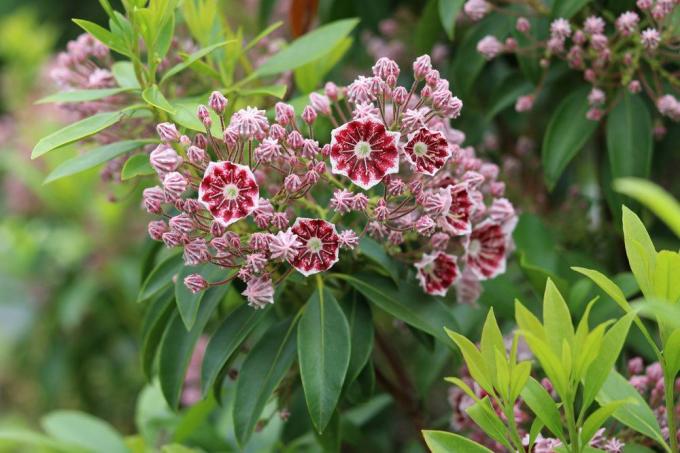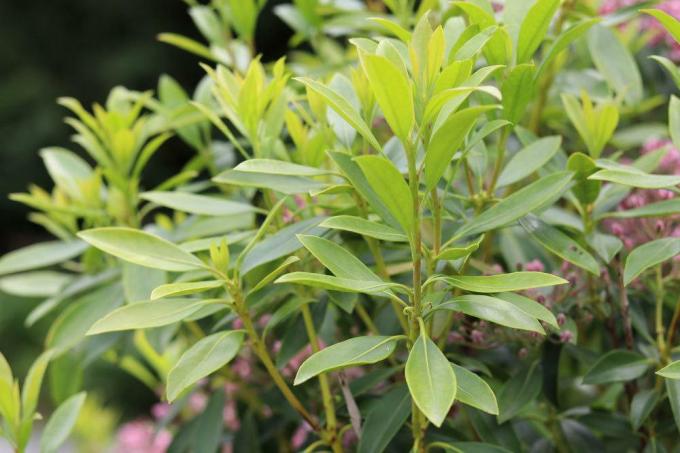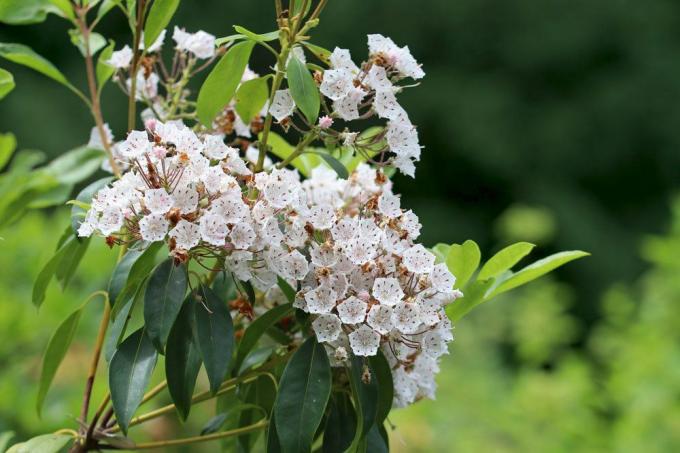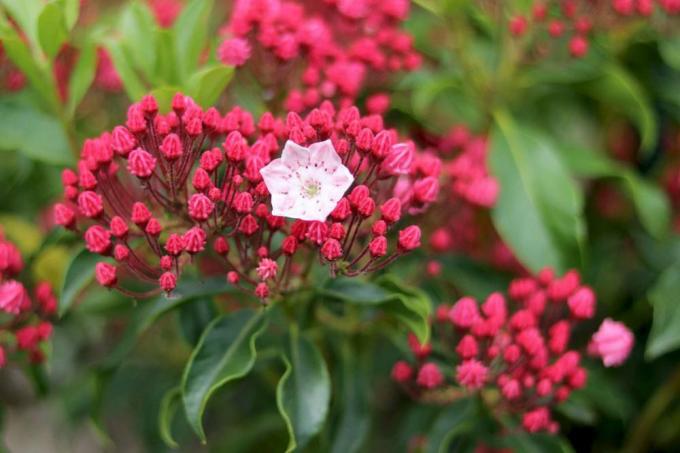
table of contents
- Location
- floor
- care
- plants
- to water
- Fertilize
- Cut
- Overwinter
- Multiply
- Diseases
Profile and care information open +conclude -
- Flower color
- pink, red, white
- Location
- Partial shade, sunny, full sun
- Heyday
- April May June
- Growth habit
- upright, spreading, bushy, perennial
- height
- up to 250 centimeters high
- Soil type
- sandy, gritty
- Soil moisture
- moderately moist, fresh
- PH value
- neutral, slightly acidic
- Limescale tolerance
- Calcium intolerant
- humus
- rich in humus
- Poisonous
- Yes
- Plant families
- Heather family, Ericaceae
- Plant species
- Ornamental trees, evergreen shrubs, Ground cover
- Garden style
- Heath garden, bog bed, ornamental garden
The mountain laurel is rarely seen in the gardens at home. Kalmia latifolia is also not very common as a container plant. And that despite the fact that it produces beautiful flowers from April to June. The shrub from the heather family is also undemanding to care for. Only the location should be carefully considered. The plant grows slowly and reaches a height of around one meter. Therefore it is also suitable for small ornamental gardens. It is also rarely attacked by pests and luckily diseases occur very rarely. So what's the catch? The mountain laurel is very poisonous. Its poison is deadly to animals and humans. The bay rose does not fit in households with small children or in those with pets or farm animals. For the mindful plant lover, however, it is a real asset.
Location
As far as its location is concerned, the mountain laurel is very undemanding. It prefers a sunny spot, but is also satisfied with a light and partially shaded location. The plant is hardy but sensitive to late spring frosts. Since the shrub grows very slowly, it doesn't need a lot of space. Therefore it is also suitable for small ornamental gardens. It can be planted as a solitary or in a hedge. Then the planting distance should be about half the growth width. And keep in mind that it takes years for the hedge to reach a decent height to act as a privacy screen.

- location in full sun is ideal
- no strong midday sun
- sheltered from the wind
- hardy and forest-resistant
floor
As with the location, the mountain laurel does not place high demands on the soil. The soil should primarily be permeable and loose. The plant does not like calcareous soils.
- moist, humus-rich soil
- neutral to slightly acidic
- loose and permeable
- Loosen heavy soils, mix with sand or small pebbles
- Heavy soils are also provided with humus
care
The mountain laurel is easy to care for. If it is satisfied with the soil and the location, it will grow without much effort, but very slowly. It grows between 10 and 30 centimeters per year. The most difficult task in caring for it is finding an ideal spot for the bay rose. The only task for the gardener is to ensure there is enough water.
plants
The bay rose is not sensitive to frost. It can be grown outdoors in the garden or as a pot plant. A frost-free day in autumn or spring should be chosen for planting out. The ideal size for the planting hole is twice the size of the root ball. To get the bay rose off to a good start, mix the excavated soil with humus, compost, or rotted leaves. A little sand should be added to heavy soil.

- Plant out between September and May
- Loosen the soil well
- Provide poorly permeable soils with a drainage layer (gravel or pottery shards)
- Water the plant well before planting
- Shape the watering edge around the plant
- The pouring rim is inclined towards the center
- water well
Bucket culture
As with planting out in the garden, care must also be taken with the container culture that the substrate is well loose and permeable. A drainage layer at the bottom of the planter is best. Since the Laurel tree Thrives very poorly in calcareous soil, should be best for bucket culture rhododendron-Earth can be used. The root ball should have enough space in the planter. Again, twice the size of the bale is ideal. After the plant is in place, it should be watered well.
to water
Once the bush has been planted, additional watering depends on the temperature and the weather. The bay rose tolerates shorter periods of drought quite well. However, if it does not rain enough, help is needed. Additional watering takes place when the soil is dry on the surface. A layer of bark mulch around the bay rose will retain moisture and prevent the soil from drying out too quickly.
When cultivating as a container plant, the substrate must not dry out. Here the soil must be kept evenly moist. It is best to water the mountain laurel with rain or lime-free water. However, waterlogging should be avoided.

Fertilize
A planted mountain laurel should be fertilized once a year to strengthen or stimulate their growth. The best time for this is spring. If the plant is in a nutrient-poor soil, it may well be fertilized more often. Basically, however, the following applies: less is more.
- organic fertilizer such as compost or horn shavings
- alternatively bark mulch
Repot
Due to its slow growth, the shrub does not need to be repotted every year. If the roots protrude from the tub, the plant should be moved to a new, larger planter. Since the bay rose prefers a humus-rich, permeable substrate, this should be renewed every two years. It is important that a drainage layer is created again when repotting, and that the planter is provided with drainage holes. Both measures are great for preventing waterlogging.
Cut
Since the bay rose grows slowly, it does not need regular pruning, but it is well tolerated by pruning. You can thin it out in spring and shorten the shoots regularly. This encourages the plant to grow more bushy.

To do this, cut young ones in particular:
- Plants just behind an outward-facing eye
- Complete cutback not necessary
- remove weak shoots
- Remove incorrectly growing shoots
- Thinning out is possible, but rarely necessary
Wilted flowers should be removed. Not only does it look prettier, it also stimulates the shrub to develop more flowers. If what has faded is not removed, the bay rose puts its strength into seed formation and accordingly develops fewer flowers.
Because of their toxicity, all parts of the plant that have been cut off, i.e. shoots, leaves and withered flowers, must be disposed of immediately and safely. When working on the plant itself, gloves should definitely be worn and eye and mouth protection should not be dispensed with. Older plants tend to shed the lower area. In order to hide the bald spots, low ones can be used Perennials be planted under the bush, such as forget-me-nots or purple bells.
Toxicity
All parts of the mountain laurel plant are very poisonous for humans and animals. The leaves of the mountain laurel contain a particularly high amount of poison. They can even be fatal to humans and animals. In his homeland, the USA, many sheep die every year because they have nibbled on the plant. That is why it is also called "Lambkill" there.
When working with the plant, as already mentioned, gloves should by no means be dispensed with. Wearing mouth and eye protection is also recommended. The plant is not suitable for family households with small children or households with animals. Poisoning occurs not only in dogs and cats, but also in farm animals and even horses. The poison in the mountain laurel is Acetylandromedol. Symptoms of the active ingredient are nausea, vomiting, diarrhea, dizziness. In addition, there is increased salivation. In severe cases, the poison can slow down the heart and lead to respiratory paralysis.
Even skin contact with the bay rose can cause itching, redness and burning sensation. The poison of the berry is also present in its honey. Therefore, the honey must not be consumed. However, it is non-toxic to bees. Since the poison of the plant can lead to death, no risk should be taken even with non-toxic mountain laurel, which is sometimes offered in stores. So do not forego the necessary precautionary measures with these plants either.

Overwinter
The bay rose is hardy and very frost-resistant. Only plants that have been planted in rough locations need protection against the cold. Young plants should also be protected in the first few winters. Fir branches or brushwood are suitable for this. If the shrub is in a windy and cold place in the garden, it should be protected with a fleece as a precaution.
Hibernate as a container plant
The mountain laurel does not need winter quarters. With a little help, it will survive the German winter on the balcony or terrace without any problems. It is important that the root ball does not freeze through in the bucket. To do this, enclose the planter with a fleece, jute or foil. So that no cold can penetrate from the ground, it is advisable to place the plant on a styrofoam or wooden block.
Multiply
Berries can basically be propagated by cuttings or seeds. However, both forms are not very promising. Cuttings rarely take root and propagation with seeds only works in wild forms. Since you almost only get cultivated forms in the trade, this form of propagation is not necessary for the hobby gardener. The only form of propagation that may be successful is that of subsidence.
- Dig a canal in front of the selected shoot
- pull the not lignified shoot into the sewer
- cover with sufficient but not too much soil
- The tip of the shoot still has to look out
- If the shoot is weighed down with stones or other weights, it will hold its new position
- water regularly to encourage root formation
If the lowering device is very stubborn, it can be "forced" to stay on the ground with simple tools. You can keep it on the ground with tent pegs from your camping gear or a staple.

Diseases
Diseases and Pests
Diseases and pests occur very rarely in mountain laurel. Since it is poisonous, it does not taste particularly good to pests. Occasional feeding marks from caterpillars or beetles are natural pest characteristics. However, these occur to a small extent, so that countermeasures are not absolutely necessary in most cases.
Vine weevil
Unfortunately, the roots of the bay rose taste good to the larvae of the black weevil. This can lead to the death of the plant. Should you discover the dreaded beetle - easily recognizable by its trunk - take appropriate countermeasures immediately.
Leaf spot disease
When it comes to diseases, the mountain laurel is prone to what is known as leaf spot disease. It does not pose a serious threat to the bay rose, but it does not look beautiful. If the plant shows symptoms of a disease, it is mostly a matter of care errors. If there is too much fertilizer, necrosis forms on the leaf edges. Dark locations or waterlogging lead to withering, drooping shoots and, in the worst case, lead to root rot. If the evergreen leaves get unsightly, brown spots in winter, they get too much winter sun and / or too much cold gusts of wind. Therefore, choose the location according to summer and winter conditions.



